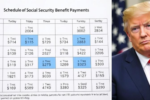In recent discussions, claims have surfaced suggesting that millions of deceased individuals, some purportedly over 100 years old, are receiving Social Security benefits. These assertions have raised concerns about potential fraud within the Social Security Administration (SSA). However, a closer examination reveals a more nuanced reality, highlighting the importance of accurate data interpretation and the challenges posed by outdated record-keeping systems.
The Reality of Centenarian Beneficiaries
According to the SSA’s latest data, approximately 90,000 beneficiaries aged 99 or older received Social Security retirement checks in December 2024. This figure aligns closely with demographic estimates, considering the increasing life expectancy and the growing number of centenarians worldwide. It’s essential to recognize that while the number of beneficiaries over 100 is substantial, it is not indicative of widespread fraud.
Addressing Claims of Payments to Deceased Individuals
Recent claims have suggested that millions of deceased individuals are still listed as alive in the SSA’s records, leading to improper benefit payments. These assertions stem from misunderstandings of the SSA’s data management practices. The SSA maintains a comprehensive database, the Numident, which contains records of all individuals issued Social Security numbers. Due to historical limitations and the transition from paper to electronic records, many older records lack updated death information. However, the presence of these records does not equate to active benefit disbursement.
A 2023 report by the SSA’s Office of the Inspector General highlighted that while approximately 18.9 million individuals born in 1920 or earlier lacked death information in the Numident, “almost none” of these individuals were receiving benefits. This distinction is crucial, as outdated records do not directly translate to fraudulent payments.
The Challenge of Outdated Record-Keeping Systems
The SSA’s record-keeping challenges are partly attributed to its reliance on legacy systems, some dating back several decades. These systems, developed in an era of limited digital infrastructure, often default to placeholder dates when exact information is unavailable. For instance, if a death date isn’t recorded, the system might default to an improbably old age, leading to misconceptions about the number of centenarians receiving benefits.
Efforts to modernize these systems have been ongoing. However, the scale and complexity of overhauling a system that manages records for millions of individuals present significant challenges. The SSA has been working to update its databases, but this process requires substantial resources and time.
Ensuring Accuracy in Benefit Disbursement
The SSA has implemented multiple measures to ensure that benefits are disbursed accurately and only to eligible individuals. These include cross-referencing records with other federal and state databases, as well as implementing stringent verification processes for beneficiaries, especially those of advanced age. While no system is entirely foolproof, the SSA’s efforts have been effective in minimizing improper payments.
It’s also worth noting that improper payments, when they do occur, are not always indicative of fraud. They can result from delays in reporting a beneficiary’s death or administrative errors. The SSA actively works to identify and rectify such issues, often recovering funds that were disbursed incorrectly.
The Importance of Accurate Data Interpretation
Misinterpretations of SSA data can lead to misconceptions about the prevalence of fraud within the system. It’s essential to differentiate between outdated records and actual benefit payments. While the presence of records for individuals over 100 years old without recorded death dates might seem alarming, these records do not imply that benefits are being paid out to deceased individuals.
Experts emphasize the need for careful analysis and understanding of the data before drawing conclusions. Kathleen Romig, director of Social Security and disability policy at the Center on Budget and Policy Priorities, points out that the numbers being cited in some claims are “so ridiculous. It’s not true.” Such statements underscore the importance of relying on accurate data and expert analysis when discussing Social Security disbursements.
Conclusion
The narrative that millions of deceased centenarians are receiving Social Security benefits is not supported by the evidence. While the SSA’s records do contain anomalies due to historical data entry practices and outdated systems, these do not equate to fraudulent benefit payments. Ongoing efforts to modernize the SSA’s infrastructure aim to address these discrepancies, ensuring that the system remains robust and reliable.
As discussions about Social Security continue, it’s imperative to base conclusions on accurate data and to understand the complexities inherent in managing such a vast and vital program.
For more detailed information about Social Security records and payment accuracy, visit Social Security Administration.
Disclaimer – Our team has carefully fact-checked this article to make sure it’s accurate and free from any misinformation. We’re dedicated to keeping our content honest and reliable for our readers.







